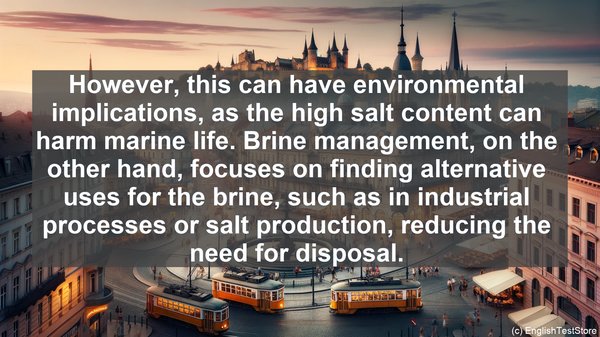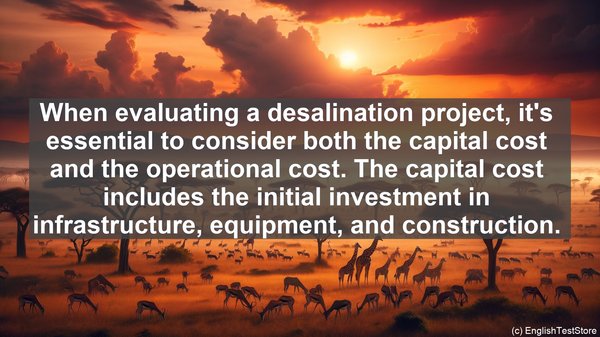Introduction
Welcome to today’s lesson on water desalination. In this lesson, we’ll be discussing the top 10 commonly confused words in this field. Understanding these terms is crucial for a comprehensive understanding of the subject. So, let’s dive in!
1. Osmosis vs. Reverse Osmosis
Osmosis and reverse osmosis are often used interchangeably, but they have distinct meanings. Osmosis refers to the movement of solvent molecules from an area of low solute concentration to high solute concentration through a semi-permeable membrane. On the other hand, reverse osmosis involves applying external pressure to reverse the natural osmotic flow, resulting in the separation of solute and solvent. It’s important to differentiate between these two processes as they have different applications in water desalination.
2. Distillation vs. Filtration
Distillation and filtration are both methods used to purify water, but they differ in the mechanism. Distillation involves heating the water to create vapor, which is then condensed to obtain pure water. Filtration, on the other hand, uses a physical barrier to separate impurities from the water. While both methods are effective, they are suitable for different situations. Distillation is often used for desalination, while filtration is commonly employed for removing particulate matter.
3. Brackish vs. Seawater
Brackish water and seawater are two types of water sources for desalination. Brackish water has a lower salinity compared to seawater. It typically contains around 1,000 to 10,000 parts per million (ppm) of dissolved salts, while seawater has an average salinity of about 35,000 ppm. The desalination process for these two sources may vary, so it’s essential to correctly identify the type of water being treated.
4. Pre-Treatment vs. Post-Treatment
Pre-treatment and post-treatment are stages in the desalination process. Pre-treatment involves the removal of large particles, organic matter, and other impurities before the water enters the main desalination unit. Post-treatment, on the other hand, focuses on adjusting the water’s pH, remineralization, and disinfection. Both stages are crucial for ensuring the quality of the desalinated water.
5. Recovery Rate vs. Conversion Rate
Recovery rate and conversion rate are two performance indicators in desalination. Recovery rate refers to the percentage of feedwater that is converted into product water. It is influenced by factors like the type of membrane used and the operating conditions. Conversion rate, on the other hand, measures the efficiency of the desalination process in terms of salt removal. It indicates the percentage of salt that is removed from the feedwater. Both rates are important for evaluating the desalination system’s performance.
6. Energy Intensive vs. Energy Efficient
Desalination is an energy-intensive process, meaning it requires a significant amount of energy to operate. However, advancements in technology have led to the development of more energy-efficient desalination methods. These methods aim to minimize energy consumption while maintaining the desired level of water quality. The choice of desalination method should consider both the energy requirements and the desired output.
7. Batch Process vs. Continuous Process
Desalination processes can be categorized as either batch or continuous. In a batch process, a fixed volume of water is treated at a time. Once the treatment is complete, the next batch is processed. Continuous processes, on the other hand, operate continuously, with a constant flow of water through the system. The choice between these two processes depends on factors like the required capacity and the nature of the water source.
8. Scaling vs. Fouling
Scaling and fouling are common issues in desalination systems. Scaling occurs when dissolved salts precipitate and form deposits on the membrane surface, reducing its efficiency. Fouling, on the other hand, refers to the accumulation of organic and inorganic matter on the membrane, leading to reduced permeability. Both scaling and fouling can negatively impact the desalination process, and regular cleaning and maintenance are necessary to mitigate these issues.
9. Brine Disposal vs. Brine Management
Brine, the concentrated salt solution produced during desalination, needs to be properly managed. Brine disposal involves discharging the concentrated solution back into the sea or a water body. However, this can have environmental implications, as the high salt content can harm marine life. Brine management, on the other hand, focuses on finding alternative uses for the brine, such as in industrial processes or salt production, reducing the need for disposal.

10. Capital Cost vs. Operational Cost
When evaluating a desalination project, it’s essential to consider both the capital cost and the operational cost. The capital cost includes the initial investment in infrastructure, equipment, and construction. Operational costs, on the other hand, encompass the ongoing expenses, such as energy, maintenance, and labor. Balancing both costs is crucial to ensure the long-term viability of a desalination project.

